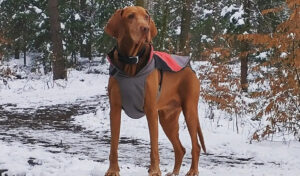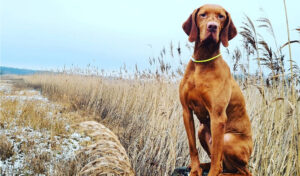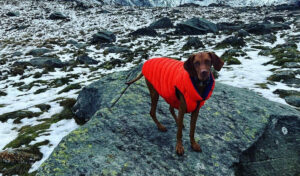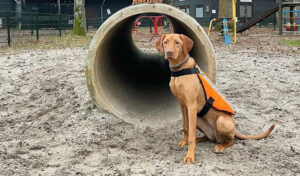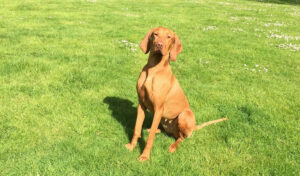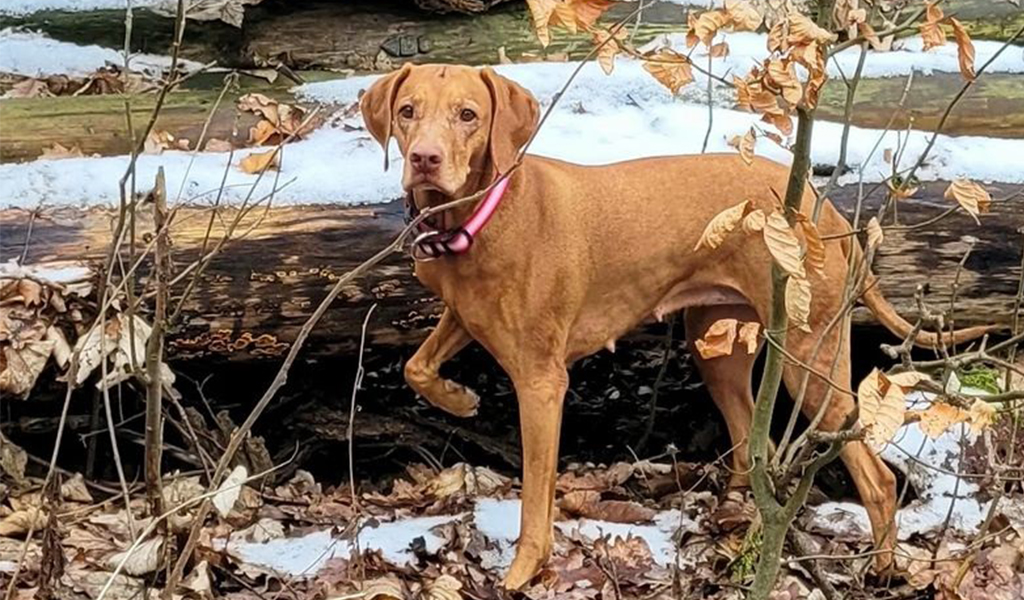What is a Vizsla Dog Breed?
The Vizsla dog breed originates from Hungary and is medium in size. They are elegant and spirited trotters with exceptional endurance, making them the perfect running or cycling partner. Vizsla are sensitive and pick things up quickly if they receive proper praise and attention.
The Vizsla lean, muscular frame gives it field endurance and speed. For the active owner who spends a lot of time outdoors, the Vizsla is an excellent companion.
Content Overview
- History
- Different names
- Appearance and Characteristics
- Personality and Temperament
- Health & problems
- How to take care
- Puppy Information
- Puppy price
- Things to consider adopting a puppy
- Advantages & Disadvantages
- Photo gallery
Vizsla Dog History
The Vizsla Dog also known as the Hungarian Pointer, has a long history. The Vizsla was a dog used as a hunting partner and companion by the Magyar warriors when they conquered Central Europe during the Dark Ages.
The Vizsla-like dog and a Magyar warrior are seen together in an artwork from the first decade of the tenth century. Hungarian nobles took to this breed with ease. The Vizsla is an energetic, athletic breed. It makes a great hunting partner and friend.
After World War I, the Vizsla came dangerously close to extinction, but its supporters preserved it. Many Hungarians left Russian occupation in 1945 during World War II, taking their Vizsla with them. Vizsla made a comeback in the 1950s and the American Kennel Club officially recognized the breed in the 1960s.
Different Names or Types
Vizsla Dog other names
- Hungarian Short-haired Pointing Dog
- Rovidszoru Magyar Vizsla
- Hungarian Pointer
- Magyar Vizsla
Recognized Names
Recognitions
- AKC: American Kennel Club
- UKC: United Kennel Club
- DRA: Dog Registry of America, Inc.
- FCI: Fédération Cynologique Internationale
- NZKC: New Zealand Kennel Club
- ACR: American Canine Registry
Appearance & Characteristics
The Vizsla dog is a short-coated hunting dog with a unique appearance and bearing. They are slender dogs with distinct muscles that are strong but not overly built. The Vizsla body type is comparable to the Weimaraner and Redbone Coonhound, although it is slimmer and has more clearly defined muscles.
A Vizsla dog snout always has a red color that matches the color of the coat. The docked tail of the Vizsla is much longer than that of other dogs. As they move through tough brush and vegetation, they hold the tail parallel to the ground and shake it ferociously.
A Vizsla dog coat, eyes and nail color should all be coordinated. The typical coat comes in various shades of French-lined yellow. In addition to yellow and copper-brown, the coat can also be characterized as russet gold and dark sandy gold.
Breed basic characteristics
- Country of origin: Hungary
- Breed group: Sporting
- Life span: 10-15 Years
- Size: Large
- Height: 21-25 Inch
- Weight: 40-65 Pounds
- Coat: Short
- Type: Purebred
- Shedding: infrequent
- Colors: Red Golden, Golden Rust, Red and Golden
- Also as known: Hungarian Wirehaired Vizsla, Velcro Vizsla
- Good with children: Yes
- Personality Traits: Outgoing, Friendly, Playful
- Good with pets: Yes
- Barking: Frequent
- Competitive registration: AKC, UKC, FCI, DRA, NZKC, ACR
- Eyes: Eyes of vizsla are of a medium size.
- Ears: They have smooth, rounded-edged, narrow ears.
- Body: Strong Body
Coat
The short-coated, thick, close-furred Vizsla dog breed is a popular breed. French-lined yellow coats in various tones are the norm. Other colors that might be used to characterize the coat include yellow, copper-brown, russet gold, and dark sandy gold.
Color and Markings
Common Coat Colors For This Breed Include.
- Red Golden
- Rust
- Rust Golden
- Sandy Yellow
Coat Color and Markings
The coat of vizsla is thick, short, and smooth. Since vizsla don’t have undercoats, they don’t shed a lot like other dogs that do. Their gorgeous coat may be seen in a variety of sand and golden yellow hues. The typical Vizsla hue is golden rust.
Personality and Temperament of Vizsla Dog
The Vizsla Dog are kind, gentle and expressive. He needs regular mental stimulation as he is highly motivated and trainable. This caste will become stubborn if they don’t perceive you as a strong authority figure. Trustworthy with children and a big fan of long games.
These dogs can become overly excited and active for very young children if they don’t get a lot of regular activity. Quick to adjust to family life and generally get along well with other dogs. They are extremely athletic, yet when they are not exercising, they can become violent or crazy. This breed can be difficult to control if not trained. He is clearly stressed and not at ease.
Vizsla chew frequently. The Vizsla is a hunting dog and can get along well with cats if raised with them, but should not be trusted around other pets such as guinea pigs, rabbits or hamsters. Once owners begin to demonstrate leadership, discipline, and adequate mental and physical activity, these habits can change.
Activity Requirements
Vizsla need both mental and physical activity because they were intended to be energetic hunting dogs. Although each dog is different, owners should aim for at least 30 minutes of daily physical exercise for their pets. Some dogs may require more.
Most Vizsla require regular opportunity to run hard off-leash in addition to leash walks and retrieve activities. Training should be a regular component of their daily routine since mental exercise is just as vital as physical exercise. With the exception that puppies shouldn’t run great distances until they reach adulthood at roughly 18 to 24 months, vizsla may make good running or jogging companions.
Older Vizsla are often lively and energetic. As soon as they are pups, Vizsla become a pack of energy. But you must use restraint to prevent overdoing it, which can cause joint and mobility issues.
Trainability
Vizsla need constant, positive training, starting from puppyhood. They are highly intelligent, curious and sometimes manipulative, so owners need to establish solid communication and teach good behavior.
Fortunately, they usually love training and thrive on the attention they receive. This is a sensitive breed, so early and ongoing socialization is important to ensure the dog has the confidence to enjoy a variety of activities.
With good socialization and consistent training, there are countless ways to have fun with these versatile dogs, including field trials, hunt tests, conformation, obedience, rally, agility, dock diving, barn hunts, lure coursing, scent work and tracking.
Health & Problems
Vizsla are regarded as a breed with a good life expectancy of up to 15 years. However, some health issues can affect all dogs. Let’s examine the typical Vizsla health issues that this medium-sized dog breed may have.
National Breed Club’s advised health examinations: Hip Evaluation, Ophthalmologist Evaluation, Thyroid Evaluation.
Seasonal Allergies: Atopy a seasonal allergy that causes itching and ear infections, can develop in Vizslas.
Eye Disorders: Certain eye disorders such as ocular melanosis which thickens and distorts the iris and, in rare cases, leads to glaucoma may occur.
Epilepsy: Anti-epileptic drugs can fortunately reduce the severity of this genetic seizure disorder which may be partial or generalized.
Hip-Dysplasia: When the hip joint is malformed, it doesn’t fit well in the socket—and dysplasia is the result. This can cause pain and lameness.
Feeding Plan
Vizsla should thrive on premium dog food, whether it’s made commercially or at home under the guidance and support of you veterinarian. Any diet should be appropriate for the dog’s age. The caloric needs of individual Vizsla vary greatly, although most of them are healthy eaters.
A young, athletic dog may need four to five cups of high-calorie food per day, but an older or less active dog may need less than half that amount. Pay attention to the dog’s calorie intake and weight level as some dogs are prone to gaining weight.
Treats can be a valuable training tool, but too many can contribute to obesity. Know which foods are safe for dogs and which are not. If you have any concerns about the dog’s weight or nutrition, see a veterinarian. Fresh, clean water should always be accessible.
Living Conditions
Vizsla typically live between 10 and 15 years. Vizsla need lots of social interaction. If properly socialized, they get along with other cats and dogs. Rodents, birds and reptiles should not be kept as pets with Vizsla. They may slaughter such creatures because of their tradition of hunting.
They don’t usually bark much, but Vizsla make effective watchdogs. Well socialized dogs are friendly to strangers unless threatened. Vizsla can experience problems with separation anxiety and thunderphobia.
Owners who want a medium-sized, energetic dog for hunting, hiking and other outdoor activities can consider Vizsla. They struggle when left alone for long periods of time.
Also Read: SILKEN WINDHOUN
How to Take Care of Vizsla Dog?
The secret to a happy and healthy bond with a Vizsla is exercise as well as work in the form of dog sports or therapy work. Give him at least two and a half hours of physical activity each day, such as walking, running or fetching activities, or he can become destructive and difficult to control.
Be fair and consistent when disciplining him. Positive reinforcement techniques, such as praise, entertainment, and food rewards, work best with this. Providing the best food. It is very important to take care of his health. Careful brushing and grooming is very important.
Grooming & Brushing
Compared to other breeds, Vizsla coats require minimal maintenance. This dog has short and very silky hair. To maintain a healthy and clean coat on a young puppy, take the time to brush it every week and try to wash it once a month. If the dog gets into anything smelly, however, it may be necessary more often. Although not frequent, there is some shading. A rubber brush can be used to tame any stray hairs.
Once a week the Vizsla ears need to be cleaned to check for dirt or wax build-up. The shape of these floppy flaps can be maintained by using a moderate ear cleaner. It is also important to trim the nails every month as they can cause damage if they are too long.
While it’s best to brush a dog’s teeth daily, you can tackle plaque and freshen their breath by starting with a good scraping a few times per week. Another thing you should make sure to do is a professional dental cleaning by a veterinarian once a year.
Feed Healthy Food
The dog’s stomach is not physiologically suited for the fermentation and digestion of carbohydrates. Even grain-free kibble often includes starchy vegetables like peas and lentils. This type of diet stresses the dog’s body.
The result is increased physiological demand for insulin, glucagon, and cortisol throughout the day, as well as inflammation and stress on vital organs that, in rare cases, can result in significant medical disorders. Regardless of gender, it is important for you pet to maintain an appropriate healthy weight.
However, Vizsla have a reputation for gaining weight, so their diet should include biologically adequate protein, healthy fats, lean bones, and vegetables rich in important vitamins and minerals.
The following items should never be feed to Vizsla Dog
- Grapes or raisins
- Moldy or spoiled food of any kind
- Yeast dough
- Poultry bones
- Alcohol, beer, wine or liquor
- Salt & salty foods
- Chocolate, coffee, or tea
- Onions, chives, and garlic
- Tomato leaves stem or unripe fruit
Puppy Information
Vizsla Dog Puppy Training
The most crucial aspect of every dog breed or pet is puppy training. Since they are a breed of extremely loyal and clever dogs, vizsla are often relatively simple to teach. Breeds of dogs might be a bit challenging to teach.
Knowing some of the fundamental elements that define a relationship with a vizsla dog is crucial for you as his owner and can help you train him successfully.
Behavioral Training
Behavior training is essential for any dog. Dog Care Dog behavior training benefits greatly. If you want to quickly train a Vizsla puppy, recognize some common behavioral problems such as biting, aggression, food security, crying, mouthing, and chewing. You can train you dog to avoid these problems.
Obedience Training
This is the most basic and important training for every dog. A Vizsla dog can be trained using three different methods, but they all begin with a thorough understanding of the five basic obedience commands: come, sit, stay, heel and down. Every dog should be taught these five basic commands because they are essential to teaching them obedience.
Socialization
The dog should be sociable. Socialization should generally begin as soon as practical. The socialization process involves exposing the dog to various situations, people, animals, sights and smells. Fortunately, social opportunities can be found almost anywhere.
Dog parks, pet-friendly restaurants, pet supply businesses and new walking trails are great places to start. It’s a good idea to occasionally take the dog or some friends over to someone else’s house.
Vizsla Dog Puppies For Sale
The Vizsla was initially developed as a hunting dog. They are frequently maintained as companion animals nowadays. Around the world, many are still used for hunting. Although there are pups available for as little as $500 and as much as $1,700, the average dog costs approximately $1,000.
Things to Consider Adopting a Vizsla Dog
- The Hungarian Vizsla is a hunting breed that requires a lot of activity due to its high level of energy.
- This breed is incredibly intelligent and is capable of learning many abilities and stunts.
- This breed must be adequately socialized in order to avoid becoming fearsome and antisocial.
- Vizsla are capable of being sociable dogs, but you must devote a lot of work to socializing these dogs.
- This might not be the best option for you if you reside in a tiny apartment or house in a city or other metropolitan area with little room both inside and outside.
Advantages and Disadvantages
Advantages of Vizsla Dog
- They are very easy to grooming
- He is a devoted best friend
- They are easy to train.
Disadvantages of Vizsla Dog
- They are not suitable for apartments.
- They worry about separation.
- The vizsla dog barks a lot.
Vizsla Dog Photo Gallery
